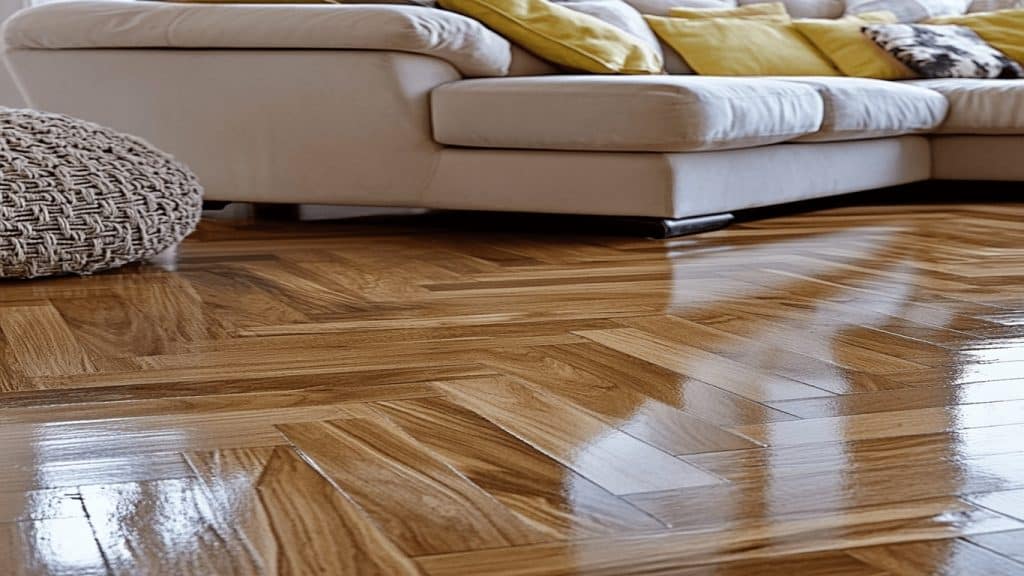
Upgrade the warmth and luxury of your home with parquet flooring for underfloor heating. Discover the perfect blend of tradition and technology in this detailed guide…
Originally used as a replacement for porcelain or ceramic, marble and stone floors, parquet flooring has become mainstream in contemporary homes. For those that may or may not already have underfloor heating systems installed in their homes, combining parquet flooring with underfloor heating can offer limitless benefits. In this article, we will explore how you can pair parquet flooring with underfloor heating, from essential installation tips, to what benefits it can offer you and the rest of your home.
Key points:
- Understand what engineered parquet flooring is and why it’s suited for underfloor heating.
- Explore the types of parquet flooring that work best with radiant floor heating.
- Learn about the installation procedures for ensuring the longevity and effectiveness of your flooring.
- Discover the unique benefits of combining parquet flooring with underfloor heating.
- Consider the latest trends and innovations in parquet flooring designs compatible with heating systems.
Choosing Parquet for Heated Floors
When it comes to improving home comfort and style, parquet flooring under underfloor heating is an excellent choice.
Engineered parquet flooring, with its robust structure and thermal compatibility, is particularly suited for use with underfloor heating systems, including electric and wet underfloor heating. This type of flooring improves energy efficiency as well as the aesthetic appeal of your home. The heat-resistant nature of engineered wood allows for a uniform heat distribution, making your living space cosy and consistently warm, making those harsh UK winters a lot more comfortable.
Key Benefits of Parquet with Underfloor Heating
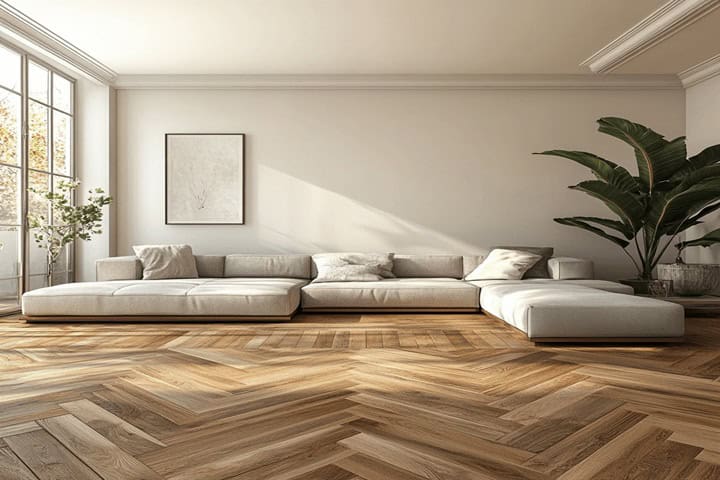
Installing parquet flooring over underfloor heating offers several advantages, including the following:
- Minimal Thermal Resistance: The layered construction of engineered parquet ensures minimal thermal resistance, allowing the heat to permeate effectively without damaging the wood.
- Insulation: The natural insulation properties of parquet wood means that your heating system can be operated more efficiently.
- Reduced Energy Costs: Unlike traditional heating systems such as wall heaters, parquet flooring with underfloor heating will reduce the need to leave the systems running to heat the designated spot, thereby reducing your energy bills.
- Healthy Living Space: Parquet flooring also contributes to a healthier living environment by reducing air currents that can stir up dust and allergens (see our guide on heat and asthma that discusses the correlation that heat in homes can have on dust mites).
Debunking Myths about Parquet Flooring with Underfloor Heating
Many homeowners hesitate to combine parquet flooring with underfloor heating due to common myths. Let’s set the record straight:
| Myth | Fact |
| Parquet wood warps easily with heat | Engineered parquet flooring is specifically designed to handle temperature changes, ensuring stability and durability. |
| Underfloor heating with wood is inefficient | Modern underfloor heating systems are highly efficient, distributing warmth evenly and improving the thermal comfort of wood floors without excessive energy use. |
Parquet Flooring Options
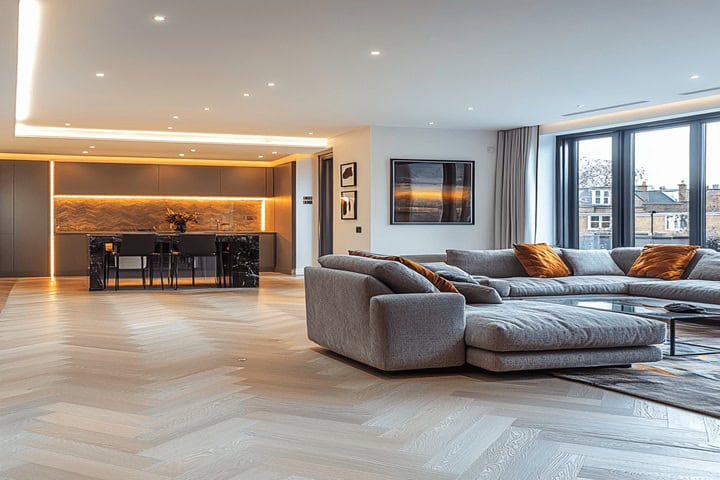
Parquet flooring is not a one-size-fits-all option; in fact, there are several options that you should be aware of in order to understand which one is better suited for your home:
1. Engineered Parquet Panels
One popular choice for homes with underfloor heating is engineered parquet panels. These panels are designed with a top layer of hardwood, typically ranging from 4mm to 6mm, attached to a stable cross-ply base.
The tongue and groove edges facilitate a seamless and hassle-free installation, making it a practical option for those seeking both elegance and ease of fitting.
2. Engineered Parquet Blocks
For those looking for a flooring option that is both versatile and durable, engineered parquet blocks are an ideal option. Available in thicknesses of 15mm or 20mm, these blocks are finished with precision and are known for their simple installation and high quality.
The variety of pre-finished styles available allows homeowners to find the perfect match for their decor, ensuring that both functionality and fashion are addressed.
3. Solid Parquet Blocks
Solid parquet blocks offer a more traditional approach to parquet flooring. These blocks are designed to be affixed directly onto a sturdy marine-grade ply subfloor, providing a solid and durable flooring solution.
While they require a bit more effort to install correctly, they allow for extensive customisation through staining or oiling, enabling a personalised touch to your flooring.
How To Install Underfloor Heating with Parquet Flooring
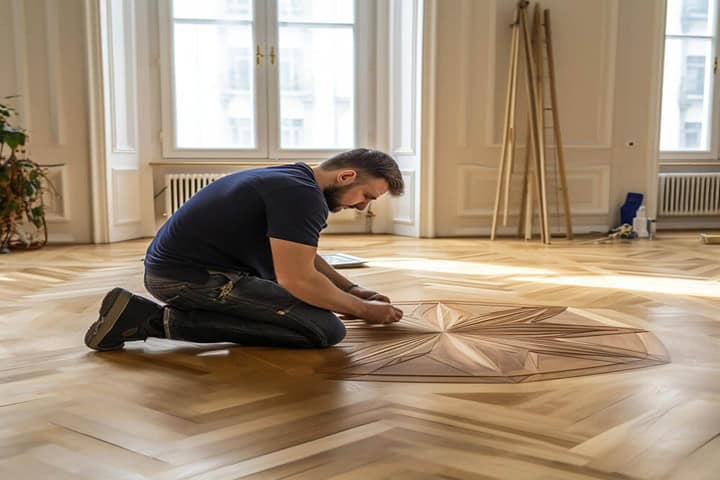
Now that you are aware of the benefits and flooring options available with parquet flooring, you now need to understand the intricate process on how to install underfloor heating with parquet floor to avoid common underfloor heating mistakes that are easy to make:
1. Preparation and Planning
Installing underfloor heating under parquet flooring requires thorough and precise preparation to ensure both efficiency and durability.
Suitable underfloor heating systems that you can implement with parquet flooring include hot water (hydronic), infrared, and electric underfloor heating.
It is crucial to select the right type of system that aligns with your flooring to optimise heat distribution and preserve the integrity of the wood.
2. Screed Application and Drying Process
The foundation for your underfloor heating is the screed, which must be professionally installed to guarantee proper functioning.
For cement screed, a minimum drying time of 21 days is recommended, whereas calcium sulphate screed should dry for at least 7 days.
Following the initial drying, the screed should undergo functional heating for a week to ensure it is stable and ready enough for the final floor covering.
To ensure the screed functions properly alongside the flooring and underfloor heating system, learn how long it takes for screed to dry.
3. Heating and Temperature Regulation
Begin the heating process at a conservative and adjustable 25°C, gradually increasing the temperature by 10°C daily until reaching the maximum of 55°C.
Maintain this peak temperature for 11 consecutive days without reducing it at night to stabilise the screed.
After this phase, gradually decrease the temperature back to the initial 25°C. Controlling the temperature this way helps to prevent any damage to the screed and ensures it is thoroughly prepared for the parquet installation.
4. Moisture Testing and Final Checks
Before laying the parquet, it is critical to test the screed for residual moisture. Acceptable moisture levels should not exceed 1.8 CM% for cement screed and 0.3 CM% for calcium sulphate screed.
If the screed meets these criteria, it is ready for the parquet to be laid. If not, continue the heating process and check again after a few days.
5. Laying the Parquet
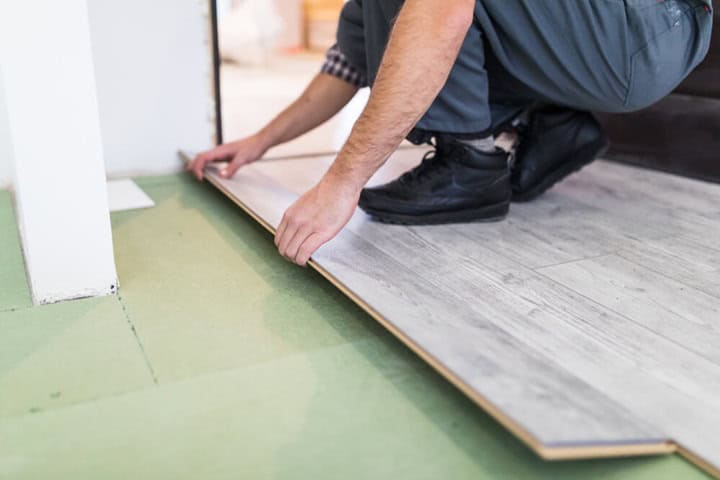
Once the screed is dry and the moisture levels are appropriate, you can proceed with laying your parquet flooring. Ensure the screed’s surface temperature is at least 15°C, with a room temperature of 18°C and a relative humidity no higher than 65%.
After installation, maintain these environmental conditions for an additional five days to allow the parquet to acclimate properly.
Enjoying Your New Flooring
With the underfloor heating and parquet flooring properly installed, you can now enjoy the comfort and elegant aesthetic of your home. The seamless integration of these two elements not only elevates the style of your space but also provides a consistent and efficient heating solution.
How Underfloor Heating Trade Supplies Can Help With Your Flooring
With so many flooring types to choose from for your home, it is easy to get lost and confused with which option is right for you, especially when underfloor heating is added into the equation. But never fear, because you can contact us today and see how our experts can answer any queries that you may have with your flooring.
We also have an array of articles on our blog about how to install various flooring types with underfloor heating, such as:
- Underfloor heating with timber floors
- Vinyl flooring with underfloor heating
- Laminate flooring for underfloor heating
- What is the best flooring for underfloor heating?
In conclusion, parquet flooring combined with underfloor heating offers plenty of benefits to your home, from its style to affordable heating options. By choosing the right engineered parquet and following precise installation guidelines, homeowners can enjoy a durable, efficient, and aesthetically pleasing flooring solution.
Want to learn more about wooden flooring? Check out this recommended guide by Which? about the types of wood floors.
FAQs
What type of parquet flooring is best for underfloor heating?
Engineered wood parquet is the best choice for underfloor heating. It is designed with layers that provide greater stability, reducing the risk of expansion or contraction due to the fluctuating temperatures of underfloor heating systems.
How does underfloor heating affect parquet flooring?
Underfloor heating can cause parquet flooring to expand and contract slightly due to temperature changes. However, if installed correctly and with suitable materials, this should not cause significant issues. Maintaining a consistent temperature and avoiding sudden, extreme changes can help preserve the flooring’s integrity.
Sources
Morgan, T., (2024) Types of wood flooring. Which? [online] Available at: https://www.which.co.uk/reviews/wood-flooring/article/types-of-wood-flooring-anOTD5N95eqj [accessed 19/08/24]
